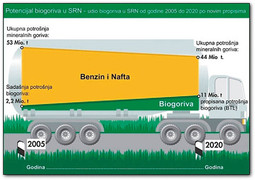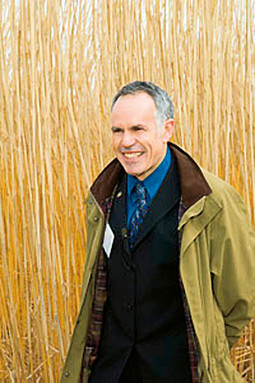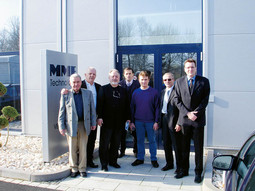Published in Nacional number 666, 2008-08-19
New renewable energy source
2.5 billion euro for biodiesel from Asian plants
The German company Genesis Projekt, in cooperation with a group of local business, plans to grow the plant miscanthus on 140 thousand hectares in in Slavonia and Slatina; these plants will then be refined in seven refineries to produce biodiesel fuel
 MARIJAN BUNIĆ AND NIKICA GABRIĆ launched the project to plant miscanthus and construct refineries to process it in Croatia Several local entrepreneurs, in cooperation with the German company Genesis Projekt, will soon begin to grow a new agricultural crop in Croatia – the Asian plant miscanthus that has proven suitable for the production of biodiesel fuel. The director of Genesis Projekt in Croatia is former banker Nikica Gabric, who quit banking after he saw a bright future in the production of biodiesel fuel.
MARIJAN BUNIĆ AND NIKICA GABRIĆ launched the project to plant miscanthus and construct refineries to process it in Croatia Several local entrepreneurs, in cooperation with the German company Genesis Projekt, will soon begin to grow a new agricultural crop in Croatia – the Asian plant miscanthus that has proven suitable for the production of biodiesel fuel. The director of Genesis Projekt in Croatia is former banker Nikica Gabric, who quit banking after he saw a bright future in the production of biodiesel fuel.
Gabric was born in Croatia, but moved to Germany at the age of four. After graduating economics and banking, he worked in a bank for ten years before taking employment at the German branch of the company Genesis Projekt, and five years ago, began preparations for the project to plant miscanthus in Croatia. His main Croatian partner is entrepreneur Marijan Bunic, who was head of the company Lira from Cakovec, where he worked until 1991. After the war, he became involved in producing energy sources from rapeseed. Five years ago, he heard about miscanthus, and contacted Genesis Projekt.
Miscanthus is a species of cane plant that cannot be eaten, unlike the rapeseed or corn that is currently used for the production of biofuel. According to Bunic, this crop can also be planted on soils of poorer quality. “High quality land, the likes of which are needed to grow food crops, are not needed for planting miscanthus. In order to start breeding, it is necessary to first build a laboratory for the production of seedlings, as the young plants are weak and this is the only way it can reproduce. In order to process the plant for biofuel, it is necessary to build a plant with special technology for that purpose. We are planning to build seven laboratories in Croatia, and construction will begin on the first in Slatina this September. We are also planning to build seven processing plants, with the first to be constructed in mid 2010 in Otok near Vinkovci. The project is worth 2.5 billion euro for the laboratories, plants and the 140,000 hectares of miscanthus plantations in the next 20 years,” says Bunic.
This is particularly important as, according to a World Bank report published by the British media in July, biofuel is responsible for up to 75% of the world’s global food price increases. The reason for this is that many farmers have begun to grow food crops for the production of biofuel, as the subsidies are higher for this kind of crop than for food crops. According to the report, this has resulted in substantial price hikes on the food market, while failing to reduce the price of traditional energy sources. Despite this, the use of biofuel is rapidly growing, as many countries want to reduce their dependence on imported oil. EU legal regulations and subventions are aiming to maximally stimulate the production and use of biofuel. As such, fuel distributers from EU Member States are required to add a certain percentage of biofuel to classical fuel and, if they fail to do so, are fined. Furthermore, all EU Member States must have a certain percentage of biofuel in the total fuel quantity distributed in its territory per year, and are required to submit a report on this to the European Commission every year.
 EUROPEAN UNION IS STIMULATING the consumption of biofuel; studies conducted by Genesis Projekta show that miscanthus has great potential Croatia also has an obligation towards the EU in the area of production of fuels from renewable energy sources. According to the obligations it has taken on, Croatia has issued a subsidy of HRK 2550 per hectare if rapeseed is cultivated exclusively for the production of biofuel. Also, the Croatian Government has issued a regulation stating that as of next year, the share of biofuel in the total share of fuel on the market must be a minimum of 5.75%, while currently, the Croatian market has only 0.3%.
EUROPEAN UNION IS STIMULATING the consumption of biofuel; studies conducted by Genesis Projekta show that miscanthus has great potential Croatia also has an obligation towards the EU in the area of production of fuels from renewable energy sources. According to the obligations it has taken on, Croatia has issued a subsidy of HRK 2550 per hectare if rapeseed is cultivated exclusively for the production of biofuel. Also, the Croatian Government has issued a regulation stating that as of next year, the share of biofuel in the total share of fuel on the market must be a minimum of 5.75%, while currently, the Croatian market has only 0.3%.
According to Nikica Gabric, this project should resolve these problems. He states that he has government support for the project. “We have written support from the Economy Ministry for the project. The project consists of three components – the laboratory for the production of seedlings, plantations and the production of synthetic biofuel. This is a long-term project, aiming to plant 140,000 hectares of miscanthus in Croatia over the next twenty years. We presented the project to the government, who is now drafting a new energy strategy that it will present to the Parliament in September. We proposed that our project be part of that strategy, and we received positive feedback. This was of exceptional importance for us because, if we were not part of the strategy, we would not be able to make this project a reality. This was a confirmation for the guarantee for the financial resources we need to realize this project,” said Gabric.
Gabric explained that construction of the first laboratory for the production of miscanthus seedlings will begin in Slatina in September. “In cooperation with the Town, we have established the company Miscanthus d.o.o. in Slatina, and just a few days ago, we bought land in the Slatina business zone. In September, we will begin construction of a 3 million euro laboratory here. The laboratory will be financed by Raiffeissen Bank and the Croatian Bank for Reconstruction and Development. This is where we will produce the miscanthus seedlings. In Novska, we established the company Energoplant Novska, which is responsible for finding and buying land for creation miscanthus plantations. These plants do not need top quality soil, and so we can find and lease or obtain a concession for second and third category soils. According to the information we have from the Ministry of Agriculture, there is about 420,000 hectares of land in Croatia which cannot serve farmers due to its poorer quality. We are currently negotiating on 40,000 hectares of land in the Virovitica-Podravina and Sisak-Moslavina Counties, which are unsuitable for raising food crops. We are also planning on leasing out large stretches of land in Lika, near the motorway,” explained Gabric.
 STEPHEN P. LONG from Illinois University has been studying the advantages and disadvantages of miscanthus exploitation for the past seven years Gabric says that they plan to construct 7 laboratories to produce up to 10 million seedlings per year, which would be sufficient to plant 7,000 hectares. Over the next 20 years, these laboratories will produce enough seedlings 140,000 hectares of land.
STEPHEN P. LONG from Illinois University has been studying the advantages and disadvantages of miscanthus exploitation for the past seven years Gabric says that they plan to construct 7 laboratories to produce up to 10 million seedlings per year, which would be sufficient to plant 7,000 hectares. Over the next 20 years, these laboratories will produce enough seedlings 140,000 hectares of land.
Gabric has also announced the construction of 7 small refineries for the production of biofuel from miscanthus. “Synthetic biofuel is produced from miscanthus plants in refineries using the MME-OM 1000 technology, which is a second generation technology. Currently, there are no such plants using this technology in Croatia. We will begin building the first such refinery this autumn in Otok near Vinkovci, and its capacity will be 100,000 tonnes per year. The project is valued at 115 million euro,” he said.
That part of the project falls under the work of the company Zeleni otok d.d., run by director Dragutin Spajic. “Negotiations have been completed, and the Nexus fund, established this past July, will invest in the construction of the refinery. We have agreed that they will invest 30 per cent of the capital required for the plant’s construction,” he said.
Miscanthus is plant that has a strong advantage over other plants for the production of biofuel. In fact, it is more suitable than rapeseed for this purpose. “One hectare of miscanthus can produce from 10 to 12 thousand litres of synthetic biofuel. Compared to rapeseed, this is a significant difference, as rapeseed can give only 1400 litres of biofuel per hectare. Furthermore, only the seed of rapeseed can be pressed in the production of biofuel, whereas the entire miscanthus plant can be used. Also, in order to successfully grow rapeseed, pesticides are required and the crop needs to be renewed every year. Miscanthus, on the other hand, has no natural plant or insect enemies, and the root of the plant will shoot new plants for 20 years once planted, and does not need to be replanted. “The costs of producing one litre of biofuel from rapeseed is between 8.5 and 9 kuna, so those without state subsidies have no chance of surviving on the market. The production of one litre of synthetic biofuel from miscanthus, with all its operative costs, stands at 3.5 kuna. Another important fact is that biofuel from rapeseed, for example, cannot be used in diesel engines, but must be mixed with mineral oil in a certain ratio. In the EU, a maximum of 10% of biofuel from rapeseed is added to mineral oil, but in Croatia this is 30%, which is the maximum limit that a modern diesel engine can handle. Synthetic biofuel made from miscanthus does not require mixing, and can be used in its original form, which satisfies the EU EN590 standard,” explained Gabric.
 GERMAN-CROATIAN TEAM Marijan Bunić, Michael Groneberg, Drago Kraljević, Alfred Naujok, Dragutin Spajić and Nikica Gabrić before the German plan where the technology for the refinery is produced Gabric says that the West has long known about the advantages of this plant. Massive plantations already exist in France (20,000 hectares), Austria (6,000 hectares), England (60,000 hectares) and Germany (40,000 hectares). As a EU Member State, Germany has subsidised the planting of miscanthus, for as an energy source, this is one of the plants that is subsidised. Miscanthus was imported to Europe from Asia more than 30 years ago, but it took the plant 20 years to adapt to the climate and become resistant. By crossing the plant with others, experts have succeeded in obtaining a variety of miscanthus that can thrive in Europe’s climate.
GERMAN-CROATIAN TEAM Marijan Bunić, Michael Groneberg, Drago Kraljević, Alfred Naujok, Dragutin Spajić and Nikica Gabrić before the German plan where the technology for the refinery is produced Gabric says that the West has long known about the advantages of this plant. Massive plantations already exist in France (20,000 hectares), Austria (6,000 hectares), England (60,000 hectares) and Germany (40,000 hectares). As a EU Member State, Germany has subsidised the planting of miscanthus, for as an energy source, this is one of the plants that is subsidised. Miscanthus was imported to Europe from Asia more than 30 years ago, but it took the plant 20 years to adapt to the climate and become resistant. By crossing the plant with others, experts have succeeded in obtaining a variety of miscanthus that can thrive in Europe’s climate.
“As of next year, Croatia will already be required to use a minimum of 5.75% of fuel from renewable sources, while the EU is planning to increase that percentage to 10% by 2015. If the planting of miscanthus goes according to the Genesis Projekt plans, by 2025, up to 60% of all the fuel need in Croatia could be produced from miscanthus using MME technology”, concluded Gabrić.
Experiments are still ongoing in the US Obtaining biofuel from miscanthus is still in the experimental phase in the US. In Denmark, experiments have been ongoing for the past 22 years, while US studies only began 7 years ago by Professor Stephen P. Long from Illinois University. Even though his studies have shown the advantages of miscanthus as compared to other agricultural crops that can be used for biofuel, they have also raised many fears about the exploitation of miscanthus. Therefore, this plant is still not in use in the US for commercial production of biofuel, but is still in the experimental phase. Long has conducted studies showing that miscanthus could become an important renewable energy source in the future. But, his studies have also shown that in the short-term, obtaining biofuel from miscanthus cannot reduce costs, as the processing technology is still exceptionally expensive. Furthermore, the Americans are still sceptical as its environmental impacts are not yet fully known.
Latest news
-
28.10.2010. / 14:15
'A profitable INA is in everyone's interest'
-
28.10.2010. / 09:38
Sanader’s eight fear SDP — Won’t bring down Government
-
21.10.2010. / 15:02
Interior Ministry turned a blind eye on Pukanic assassination
-
20.10.2010. / 09:34
Barisic could bankrupt HDZ



